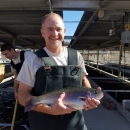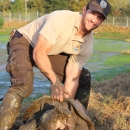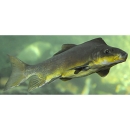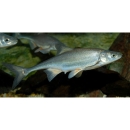Willow Beach National Fish Hatchery (NFH) is one of multiple National Fish Hatcheries in partnership with the Bureau of Reclamation, the states of Arizona, Nevada, and California working towards fulfilling the Lower Colorado River Multi-Species Conservation Program (LCRMSCP) goals of population recovery and enhancement of the endemic Razorback Sucker and Bonytail Chub fish species. Willow Beach NFH has been working with propagating the Bonytail Chub and Razorback Sucker in semi-recirculating raceways since 1995. Beginning of 2019 WBNFH has made substantial changes to Razorback Sucker and Bonytail Chub culture and operating procedures at its facility. These changes in feeding and culture regimes while replacing raceways with semi-recirculating systems using circular tanks for the Razorback Sucker has helped increase fish growth and culturing efficiency from fry to advanced fingerling stages within a 9-month growing season.
Since 2019 Willow Beach NFH staff have built outdoors new semi-recirculating systems utilizing previous raceways and added overtop circular tanks of various sizes – from 4ft up to 15ft in diameter. The idea behind using these tanks was to provide a more efficient use of water and spatial footprint while rearing these species under specific feeding and culture regimes in an environment more physiologically suited for achieving optimal fish health and condition as they grow. The circular tanks also provide both staff and visitors the opportunity to observe their behavior and view these fish up close.
Willow Beach NFH from 2019-current date have used twenty 6ft. diameter circular tanks split between two separate flow through systems indoors for nursery through fingerling rearing Razorback Suckers and Bonytail Chub species from late Winter to Fall months. Staff in 2019 updated the feeding regimes with decapsulated hatched brine shrimp product during early life stage feeding compared to the previous brine shrimp product used. The decapsulated brine shrimp allow for the hatched brine shrimp to be completely digestible and eradicates the need for manually separating the hatched brine shrimp from their cysts before feeding to early life stage fish species. In turn, elimination of early life stage mortality from accidental consumption of indigestible cysts portions within exogenous fish species consumption of hatched brine shrimp occurs.
Transitioning the young Razorback Suckers from brine shrimp to pelleted diets were implemented in various ways utilizing multiple fish feed manufacturers over the development of the Razorback Sucker program at Willow Beach NFH. Prior to the 2019 feed regime changes, the Razorback Suckers were transitioned from brine shrimp to a commercial starter larval pelleted diet, once they reached larger sizes, they were fed larger pellets extruded by a second feed manufacturer that utilized U.S. Fish and Wildlife Service’s Bozeman Fish Technology Center formulated Razorback Sucker recipe. Since 2019, Willow Beach NFH has utilized a single fish pelleted feed manufacturer that is able to duplicate the requested size range of pellets while extruding U.S. Fish and Wildlife Service's Bozeman Fish Technology Center's formulated Razorback Sucker recipe compared to the previous regime’s feed manufacturers used. Implementing these feed changes since 2019 provide exogenous and fingerling Razorback Suckers high quality specific nutritional options for feed consumption during crucial growing phases.
With these improvements by late Fall, the Razorback Sucker fingerlings have transitioned towards being able to accept larger feed sizes, are nearing 13 fish per pound, and averaging five inches or greater in total length. After reaching these larger fingerlings sizes the Razorback Suckers at Willow Beach are moved outdoors to the 15ft. diameter circular tanks within the semi-recirculating systems. Currently Willow Beach NFH has four of these tanks in production, with eight more soon to be installed between 2021-2022. With these advancements Willow Beach NFH made in propagation efforts for improving growth and culture techniques, it is possible to intensively culture higher quantity and quality advanced Razorback Sucker fingerlings for further grow-out in either intensive or extensive systems until desired stocking sizes are reached for reintroduction efforts.
Currently, the Bonytail Chub also benefit from these dietary improvements at Willow Beach NFH. Since the tank modifications from 2019, Bonytail Chub are being raised again at Willow Beach NFH in 2021. Prior to 2021, the remaining Bonytail Chub allotted within Willow Beach NFH’s inventory were completing grow-out within the satellite facility Achii Hanyo Native Fish Rearing Facility’s production ponds. Typically, both species of Razorback Sucker and Bonytail Chub are reared on site at Willow Beach NFH until reaching advanced fingerling sizes before being split between Willow Beach outdoor tanks and Achii Hanyo ponds as determined as spatially necessary to complete grow out requirements before tagging and stocking.
Once these species reach the targeted stocking size (300+mm for Razorback Sucker and Bonytail Chub) each fish of size is corralled and tagged with a passive integrated transponder (PIT) tag before being stocked into predetermined areas within the Lower Colorado River. These are tracking tags that do not require power, instead they have a coded internal microchip that is activated when it is passed under a special antenna handled by a fisheries biologist.
The fish are tagged to assist with determining population dynamics of the Razorback Sucker and Bonytail Chub once released into the Lower Colorado River. Willow Beach NFH will continue to assist with growing and stocking of these native fish species until the population enhancement and recovery goals from the Lower Colorado River Multi-Species Conservation Program are met or restructured.







